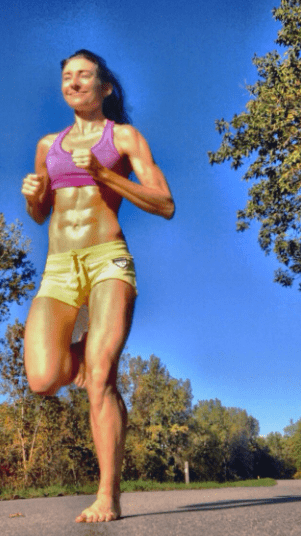The benefits of barefoot running extend WAY beyond strengthening the feet! Other barefoot running benefits include naturally activating sets of withdrawal reflexes in the leg that are vital for driving lighter, less impactful footfalls! How do we know this?
Dr. Steven Robbins MD at McGill University has published many landmark studies revealing the limitless benefits of barefooting! One line of his research revealed that running barefoot automatically triggers one of the body’s natural mechanical defenses know as avoidance behavior which also prevents other forms of injurious mechanical interference’s. This is one of the many ways in which barefoot running may put you on more steady, proactive footfalls that’s good for injury prevention as compared with thick, cushioned overly protective running shoes.
The study found that barefooted subjects demonstrated avoidance behavior in response to applied loads on different surface types, however most subjects were unaware that they were avoiding the surface, indicating that avoidance behavior must be hard-wired into our reflexive system.

More Benefits of Barefoot Running Revealed
Avoidance Behavior Comes Naturally
Avoidance behavior in the context of running is the body’s natural ability to avoid injury.
- Impaired or blocked plantar (bottom of the bare foot) proprioception (the sense though which we perceive the position and movement of our body), diminishes avoidance behavior which means the body is less likely to seek a natural behavioral response to prevent injury when proprioceptive input is weak.
Therefore, avoidance behavior in running greatly depends on plantar sensations which are enhanced only when barefoot. This is why barefoot runners may be more mechanically competent at maintaining landings of less downward force and of more stability than shod (shoe) runners.
Avoidance Behavior is a Reflex
The reason the barefoot subjects were unaware of their avoidance behavior was because avoidance behavior is unconscious or reflexive. In contrast, runners who wear thickly cushioned running shoes seem to plow the foot harder into the ground, suggesting that underfoot cushioning may interfere with the avoidance behavior reflex.
- The researchers argued that running shoes designed for high-impact environments do not modify injury-producing forces (i.e. cushioned running shoes are of little help at reducing/absorbing impact) during running which may explain the unacceptably high-rates of impact-related injuries in runners who wear thickly cushioned running shoes!
In other words, in thickly cushioned running shoes, the avoidance behavior reflex pathway is ‘lost’ or disabled which may lead to dysfunctions in motor outputs, potentially resulting in more intensive, reckless landings.
Cushioned Running Shoes Impair Key Reflexes Needed for Safer Landings
Reflexes, such as the avoidance behavior reflex, are a by-product of evolutionary adaptations and are hardwired into our neuromuscular system. Interfering with these reflexes results in balance failures and injury.
As evidence accumulates about the effectiveness of barefoot running, the researchers also found that during avoidance behavior, the unloaded leg in the barefooted subjects showed increased hip extension which indicated activation of the withdrawal reflex.
Therefore, barefoot running would allow an habitually shod runner to recapture as much reflexivity as possible for safer running.
Another essential benefit of barefoot running is mechanical interference prevention, particularly in the arch of the foot!

- When barefoot, the foot is flooded copious amounts of plantar sensory and mechano-pressure stimulation which increases muscle tone in the muscles that controls the lowering and raising of the arch. The net effect? Stronger, higher, more functional arches that are better able to be more spring-loaded which is good for running economy!
- This proves that plantar sensory feedback is the most important mediator of increasing arch strength!
In contrast, shoe materials, such as arch support, medial posts, even lacing, were found to be a significant mechanical interference, negatively affecting arch deflection, resulting in poor arch strength and function. And, don’t forget, when the arches are weak, running injuries may always be on the rise as weak arches are also indicative of weak feet!
The benefits of barefoot running are often evident after a week or so, but when performed intensively over months, barefoot running produces long-term gains that restore reflexive and motor function.
More From Run Forefoot:
- How to Run Safely in the Winter
- East African Runners Hold Their Arms Differently When Running
- Tips on Running with ITBS
- Find Your Forefoot Running Shoes
- Top of Foot Pain from Running
- Best Barefoot Running Books
References:
Robbins SE and Hanna AM. Running-related injury prevent through barefoot adaptation. Med Sci Sports Exerc, 1987; 19:148-56;
Robbins SE., Hanna AM and Gouw GJ. Overload protection: avoidance response to heavy plantar surface loading. Med Sci Sports Exerc, 1988; 20(1):85-92.
Bretta Riches
BSc Neurobiology; MSc Biomechanics candidate, ultra minimalist runner & founder of RunForefoot. I was a heel striker, always injured. I was inspired by the great Tirunesh Dibaba to try forefoot running. Now, I'm injury free. This is why I launched Run Forefoot, to advocate the health & performance benefits of forefoot running and to raise awareness on the dangers of heel striking, because the world needs to know.
Latest posts by Bretta Riches (see all)
- Does Foot Strike Really Matter in Running? YES! - 17/04/2024
- Heel Lifts Increase Injury in Runners - 16/04/2024
- Are Minimalist Shoes Good for Seniors? YES! - 14/04/2024

Leave a Reply